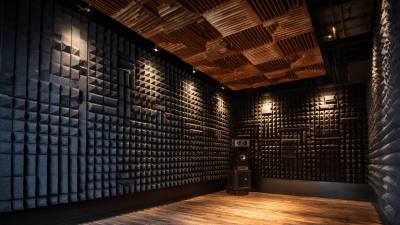In the quest for a harmonious living space, homeowners often overlook the significance of acoustics, which can greatly influence comfort and ambiance. One innovative solution gaining popularity is the use of decorative sound panels. These panels not only serve as functional acoustic treatments to reduce noise pollution and echo but also enhance the aesthetic appeal of any room. By understanding the science behind decorative sound panels, we can learn how they effectively absorb sound waves and improve overall sound quality within a home. This guide will explore how to select, install, and utilize decorative sound panels, ensuring your living environment is both visually pleasing and acoustically balanced, ultimately transforming your space into a serene retreat.

Sound waves are invisible yet powerful forces that shape our acoustic environment. In home settings, sound waves behave in specific ways, reflecting off surfaces, absorbing into materials, and refracting around obstacles. Understanding these behaviors is crucial when creating a comfortable atmosphere, as uncontrolled sound reflections can lead to echoes and muddled audio experiences. Hard surfaces like tile or glass contribute to a more chaotic sound profile, while softer materials tend to absorb sound, reducing reverberations.
Decorative sound panels are designed to manage these waves effectively, combining aesthetic appeal with acoustic functionality. They work by absorbing specific frequencies, preventing unwanted noise buildup and enhancing speech clarity and music enjoyment. These panels can be strategically placed in key areas, such as living rooms or home theaters, to optimize sound quality without compromising the visual aspects of a room. By integrating stylish sound-absorbing materials, homeowners can achieve a harmonious balance between design and acoustics, transforming their living spaces into serene and enjoyable environments.
| Material | Thickness (inches) | NRC Rating | Dimensions (inches) | Ideal Applications |
|---|---|---|---|---|
| Acoustic Foam | 2 | 0.95 | 24 x 24 | Recording Studios, Home Theaters |
| Fabric Wrapped Panels | 1 | 0.80 | 48 x 24 | Offices, Conference Rooms |
| Wood Panels | 0.75 | 0.60 | 48 x 48 | Living Rooms, Restaurants |
| Metallized Panels | 1 | 0.75 | 60 x 30 | Clubs, Theaters |
| Gypsum Board | 0.5 | 0.50 | 96 x 48 | Residential Bedrooms, Offices |
Decorative sound panels play a crucial role in enhancing room acoustics, transforming spaces into havens of auditory comfort. These panels are designed not only for aesthetic appeal but also to address common acoustic issues such as echo, reverberation, and sound dispersion. By strategically placing these panels around a room, one can significantly improve sound clarity and quality, making them ideal for home theaters, recording studios, or even cozy living areas where conversation matters.

The science behind these panels lies in their ability to absorb sound waves, thereby reducing the intensity of reflections. Typically made from materials like foam, fabric, or wood, decorative panels are engineered to target specific frequencies, ensuring a balanced acoustic environment. This balance is particularly beneficial in open-plan spaces or environments with hard surfaces that create disruptive echoes.
Overall, decorative sound panels not only elevate the visual aesthetics of a room but also serve a functional purpose in enhancing the overall auditory experience.
Decorative sound panels have emerged as a highly effective solution for enhancing home acoustics while adding aesthetic value to interior spaces. The materials used in these panels play a crucial role in their acoustic properties. Common materials include fiberglass, foam, and wood, each offering distinct advantages. For instance, fiberglass panels, known for their high sound absorption coefficients, can reduce noise levels significantly, achieving values up to 0.95 in certain frequencies, according to research from the National Institute of Standards and Technology.

Furthermore, acoustic foam panels, which are often seen in recording studios and home theaters, possess cellular structures that effectively trap sound waves. A study published by the Acoustical Society of America indicates that these foams can absorb up to 80% of sound in specific frequency ranges, making them ideal for reducing echoes and reverberation in spaces where clarity of sound is essential. On the other hand, wood panels not only add a sophisticated look but also provide a balanced sound diffusion, helping to create a more pleasant acoustic environment. Their effectiveness is supported by findings from the Journal of Building Acoustics, which demonstrates that wooden sound panels can enhance sound quality by dispersing audio energy evenly throughout the room.
When designing spaces with decorative sound panels, it’s essential to consider several factors that can significantly enhance their acoustic performance. The choice of materials and placement is critical; for instance, textiles, wood, and other sound-absorbing materials can reduce echo and reverberation, creating a more pleasant auditory environment. Additionally, adjusting the size and density of the panels helps tailor the sound-mitigating properties to specific room functions, whether it be a home theater, a music studio, or an open living space.
Furthermore, the design and aesthetic integration of these panels can complement the overall interior decor while actively contributing to sound quality. A well-thought-out design consideration not only focuses on visual appeal but also enhances functionality. By balancing aesthetics with sound absorption capabilities, homeowners can achieve a harmonious blend of elegance and acoustic enhancement. Innovations in material technology, similar to how engineering in tire design is informed by performance needs, continue to evolve, offering improved solutions for residential sound management.
This chart illustrates the impact of various types of decorative sound panels on sound absorption coefficients at different frequencies. The data highlights how specific panel designs can optimize acoustic performance in home environments.
The advancements in home acoustics have profound psychological benefits that extend beyond mere sound quality. Improved sound environments can significantly elevate a homeowner's experience, contributing to relaxation and mental well-being. Enhanced audio clarity and spatial dynamics create immersive experiences that engage not just the ears, but also the emotions. In spaces where sound design is prioritized, individuals often report lower stress levels and a heightened sense of enjoyment during activities such as movie watching or music listening.
Moreover, the introduction of decorative sound panels plays a crucial role in transforming how sound interacts with home interiors. These panels not only reduce echo and improve clarity but also provide aesthetic appeal. By integrating design with functionality, homeowners can create spaces that foster creativity and comfort. With a thoughtful arrangement of sound elements, it becomes possible to achieve a harmonious balance that enhances both the auditory and visual dimensions of home life, contributing to an overall enhancement in quality of living.






